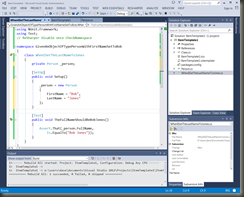 I recently had an experience writing code that proved to me, once again, that using Test Driven Development really is faster than the way I have been working. You will remember a couple of weeks ago I presented a strategy for creating test scenarios where we need to test storing data to a database from a web page.
I recently had an experience writing code that proved to me, once again, that using Test Driven Development really is faster than the way I have been working. You will remember a couple of weeks ago I presented a strategy for creating test scenarios where we need to test storing data to a database from a web page.
Dave's Notebook
Treat Warnings As Errors
 I used to ignore warnings when I compiled my code. Most of the time they never caused any problems and I was able to run my code. But recently I’ve gotten pickier about my code. One area I’ve gotten more picky about is compiler warnings.
I used to ignore warnings when I compiled my code. Most of the time they never caused any problems and I was able to run my code. But recently I’ve gotten pickier about my code. One area I’ve gotten more picky about is compiler warnings.
Any code that I have direct control over now compiles cleanly. No errors and no warnings. This past week I found a perfect example of why. Given the following code:
The Proper Function of QA
 With all this talk of test driven development, one has to naturally ask, “Where does the QA department fit in? Do they even have a role in the organization any more?” Well, the answer to that is, “absolutely but probably not the role they think they have.”
With all this talk of test driven development, one has to naturally ask, “Where does the QA department fit in? Do they even have a role in the organization any more?” Well, the answer to that is, “absolutely but probably not the role they think they have.”
Don’t Comment Out That Test
 First, at the suggestion of one of my friends who now works at SmartBear, I’m going to experiment with creating audio of my post going forward. Obviously this will lend itself to some of my post more than others, but I think it is worth experimenting with. Those of you who’ve been with me since the early days remember that I use to produce YouTube videos occasionally. I haven’t done that in a while because the post production process for videos takes so long. I’m hoping that I don’t run into the same problem with producing audio. Anyhow, the point of creating the audio is that many of you don’t have time to read, but would have time to listen to something on the way to work. Assuming this experiment works out, you should be able to listen to the content on this blog during your commute, or anywhere else you are likely to listen to audio. If you’d rather listen to this post, you can scroll to the bottom of this post and click the “Play” button.
First, at the suggestion of one of my friends who now works at SmartBear, I’m going to experiment with creating audio of my post going forward. Obviously this will lend itself to some of my post more than others, but I think it is worth experimenting with. Those of you who’ve been with me since the early days remember that I use to produce YouTube videos occasionally. I haven’t done that in a while because the post production process for videos takes so long. I’m hoping that I don’t run into the same problem with producing audio. Anyhow, the point of creating the audio is that many of you don’t have time to read, but would have time to listen to something on the way to work. Assuming this experiment works out, you should be able to listen to the content on this blog during your commute, or anywhere else you are likely to listen to audio. If you’d rather listen to this post, you can scroll to the bottom of this post and click the “Play” button.
Make Your Test Work For You
 So far we’ve been talking about creating test as part of the development process. If all you ever used those test for was to make the design of your systems better, you would already be far ahead of most of your peers.
So far we’ve been talking about creating test as part of the development process. If all you ever used those test for was to make the design of your systems better, you would already be far ahead of most of your peers.
But now that we have test, we might as well get as much mileage out of them as possible. To do that, we are going to run our test every time we make a change.
Now, you COULD run your test every time you make a change manually. But who has time for that? Certainly not me. I doubt you do either. And even if we did have time, there are better things we could be doing with that time if we could have those test run for us by some other process.
What Not To Test

Many people believe that implementing Test Driven Development means that you need to have a test for every line of code in your system. When they start thinking about TDD in this way, they start to feel overwhelmed and quit before they even start.
I know I did.
In fact, I’ve seen suggestions on places like StackOverflow that suggest as much.
But there is code in your application that you shouldn’t bother to write a test for.
Automated Web Application Functional Testing

One problem we often have when performing application test is that if we are testing applications that modify the database in some way, we can’t test without modifying the database.
In an ideal world, one way you could deal with this issue is to create a test database that has known data. But even then, you have to go through the effort of setting up the data prior to each test.
To be clear, I’m not talking about unit test. You should have unit test for most of your code. I’ll handle what not to test in some other post. But, at some point you will want to put together a suite of test that ensures that the application, as a whole, does what you expect it to do.
So, the stated problem is this, “How do we test a web application in such a way that we are always working with known data and in such a way that we do not ever modify the data in the database?”
So far, I’ve not found a way that test the whole web application from the user interface down to the database. But, I think I’ve found the next best thing. Split the application in half between the view and the database and perform two, overlapping, integration test. If both work, we can reasonably assume that the whole application works.
So how would we go about doing this?
If you’ve designed your application correctly, you should have a seam somewhere in the center. In my code it tends to either be at the business logic layer or at the data access layer. What we want to do is to create a separate class, or set of classes that look just like the classes at that layer and swap them in while testing the top half of our application and use the real classes when testing the bottom half of the application and when using the application in production.
We do this using dependency injection using your favorite dependency injection framework. I’m not going to go into the details of dependency injection here. Maybe some other day. But this is a place where you would use it.
Test the top half
In the fake DAL or BLL classes, what you are going to do is return what amounts to hard coded values. In a recent implementation, I stored the JSON representation of the values in a resource (RESX) file using the parameters that were passed into the method call as keys so that I could retrieve that data. If you need to do an update, you will need to store that some place so that your test code can verify that it got passed down to the function that should have saved it to the database.
By doing this, you can verify that your code from the presentation layer down to this seam works as it should. Now we need to test the bottom half of our code.
Test the bottom half
This will be a bit easier. What we do here is we have our test code run the code directly. But, unlike when we run the code in production, we will wrap the code in transaction tracking starting with our setup method. We turn on transaction tracking, get the database into the state that we need for testing, run our test, and then rollback the changes. Assuming the transaction tracking works correctly, and we have to assume that our third party tools do, this test everything without modifying the database.
Because we’ve tested both the top half of the code and the bottom half of the code, we now have a reasonable assurance that the code as a whole works as it should.
TDD Isn’t All About Testing
 While the artifact of Test Driven Development is test code, what you get out of test driven development far exceeds the test themselves.
While the artifact of Test Driven Development is test code, what you get out of test driven development far exceeds the test themselves.
When You Really Need All Of Your NUnit Test In One Class

Last week I proposed a structure for unit test that follows the pre-condition, action, post-condition workflow. Basically what you would see in a Use Case document.
The result of this structure when applied to a general NUnit class is that we will end up with our pre-condition and action in our setup method and our post-condition asserts in our test methods.
The problem with this is that sometimes this doesn’t always fit what we are trying to do.
Unit Test Structure
 One of the recurring reasons I hear from people for why they are not implementing unit test in their code is because it takes too long. On one level I get that. But, my experience tells me that the real problem is more likely that they just don’t understand enough about how to implement unit testing to be able to do it well.
One of the recurring reasons I hear from people for why they are not implementing unit test in their code is because it takes too long. On one level I get that. But, my experience tells me that the real problem is more likely that they just don’t understand enough about how to implement unit testing to be able to do it well.
This is like knowing you are supposed to “eat right” and “exercise” but not having anyone tell you how to do either in such a way that you can maintain the habit.